Having a vigorous and healthy sourdough starter is the first step to baking great sourdough breads, rolls, muffins, and more.
In this post I will walk you through the care of a new starter, help you determine how much starter to keep on hand, and outline the steps of feeding your sourdough starter in preparation for baking.
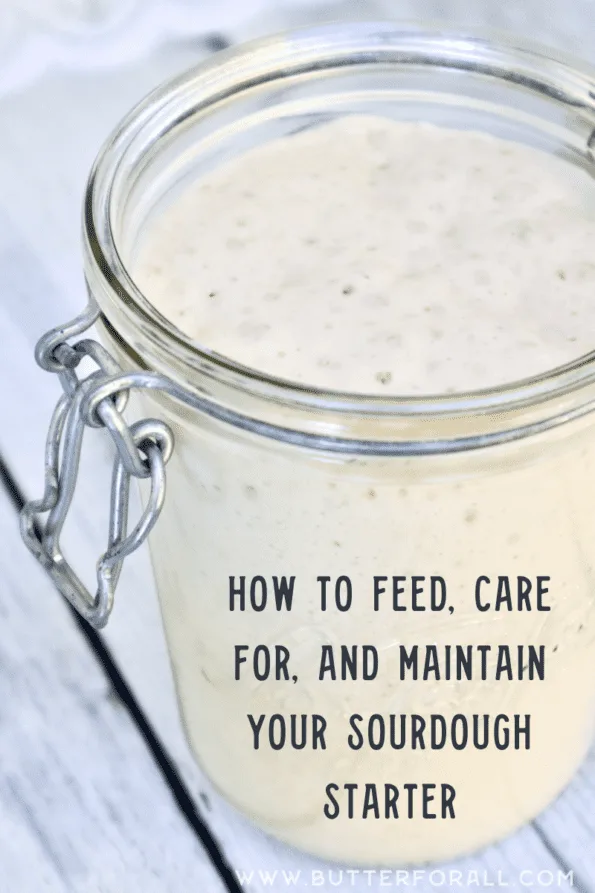
With Sourdough Starter, Consistency is Key.
I bake or cook with my starter at least twice a week, so my starter is constantly being refreshed with flour. The fresh flour is an ideal food source for the happy yeast and bacteria within the starter.
If you are just getting started with sourdough, I recommend you read my comprehensive guide on sourdough fundamentals.
This guide will give you an in-depth look at the complex bacterial systems working inside the starter. It will arm you with all the important terminology and explain what sourdough is and why it is better for you. And it will delve into the history of sourdough and its controversial usurper, rapid-rise yeast.
Demystifying Sourdough – Everything You’ve Ever Wanted To Know About Sourdough Starter – Why It’s Better for You and How To Start One
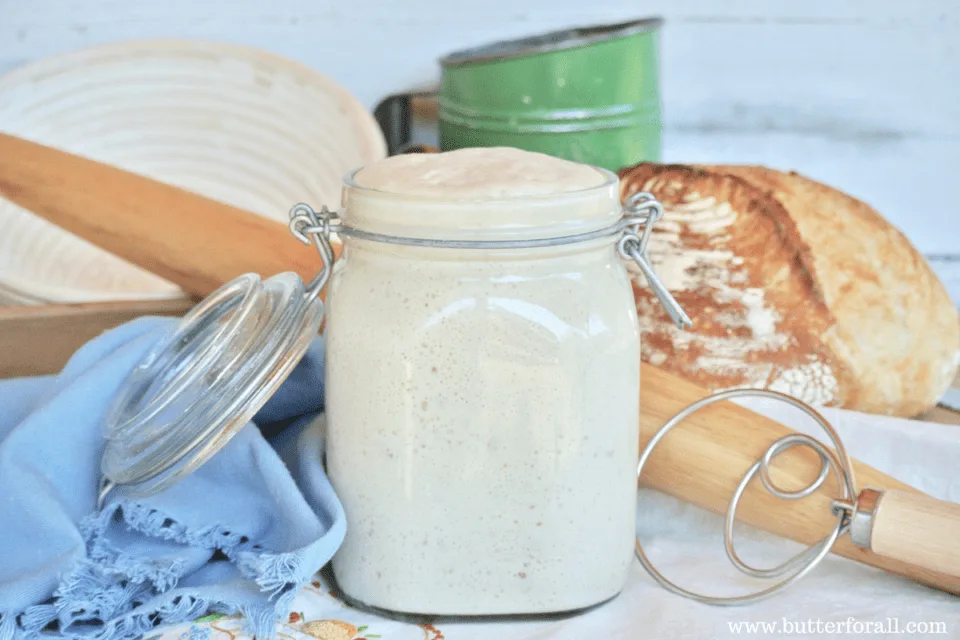
Caring for a New Sourdough Starter
Keep it small so you don’t waste flour.
You won’t want to use your starter for discard projects until it is at least one week old. You won’t use your starter for bread until it is very active, usually two or more weeks.
Discard 50% and feed daily.
In the beginning, you actually want to discard. Just go ahead and compost the starter that is removed from the jar.
Use equal weight flour to water (100% hydration).
This is the best ratio for a starter that is thick and easy to work with, plus most of my recipes and many others call for a starter that is 100% hydration.
Keep your jar clean.
Feed and mix your starter in a small bowl to really incorporate and aerate the ingredients. The extra oxygenation will give your fermentation a boost. Then transfer your starter to a clean jar for storage and fermentation.
Let it breathe.
Use a jar with a loose-fitting lid. I like a locking lid jar with the rubber seal removed. You want a little fresh air but not enough to dry out the top layer of starter or introduce dust or bugs.
Watch it closely. Look for signs of hunger.
My starter recipe advises daily feeding for the first week and twice-daily feeding for the second week. But sometimes starters can get really hungry during the first weeks so it’s great to watch it closely and feed it whenever it has gone flat or there is liquid “hootch” forming on the top.
Increase feedings as activity increases.
As your starter starts to come alive, feed it more regularly to give the yeast the boost they need to get them ready for bread making.
Grow it when it’s ready.
When the starter is consistently doubling in volume in 4 to 8 hours, you can make a bigger starter by increasing the amount of flour and water during feedings. This will allow you to build the starter up to the desired size for baking projects.
Time how long it takes to double in volume.
Paying attention to your starter is key. You want to get to know its preferences and fluctuations. Does it like a warm spot in the kitchen? Or does it rise well in the refrigerator? Knowing how long it takes to double in different environments will help when it’s time to ferment your bread or other doughs and batters.
Use it and feed it frequently.
Best:
Using and feeding your starter weekly or more.
This schedule will keep your starter in tip-top shape; ready for anything you can think up!
Okay:
Using your starter every other week is still okay.
Your starter will most likely need an extra discard and feeding before using.
Borderline neglect:
Using your starter monthly or even longer between uses.
Life happens. I get it. I have let my starter languish for six months in the refrigerator during a busy and stressful time. You will definitely need to feed your starter two or more times prior to baking, a process that takes at least 8 to 12 hours per feeding.
Don’t let it go to bed hungry.
Always feed your starter and allow it to start fermenting before storing it in the refrigerator. This will give the yeast and bacteria some energy to keep them happy during cold storage.
Don’t give up!
So many people give up on sourdough baking because they get overwhelmed by the maintenance process. It can seem daunting, but in reality it’s a fairly straightforward process and the rest of this article is going to break it down further to make it even easier on you.
The next step is to determine how much starter you want to have on hand for your needs.
How Much Starter Do You Need to Keep?
There are two main ways of keeping starter on hand for sourdough projects. You can keep a little or a lot. What’s the difference? Well, let me discuss.
A. Keep a small starter (50 to 100 grams) and feed it as needed.
This is a great option for the occasional baker who doesn’t want to mess around with using a lot of fully fermented sourdough starter out of the refrigerator.
For this method a small starter is kept stored under refrigeration. When needed, it is removed from the refrigerator and the starter is built up to the desired volume over the course of a day or two prior to being used.
Pros: Less space needed, less potential waste.
Cons: Starter is not available for immediate use, requires planning ahead.
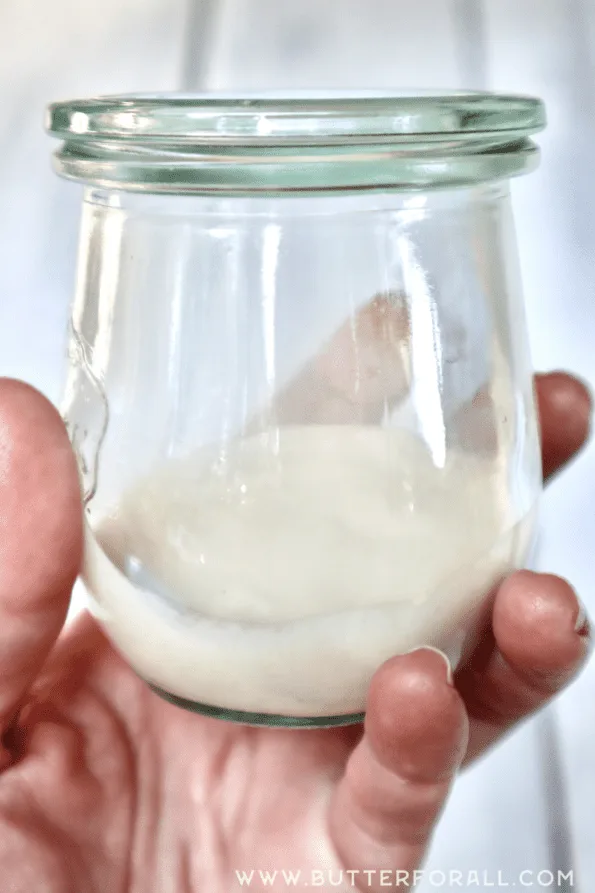
B. Keep a large starter (300 to 500 grams) and use it liberally.
This option works really well for people who have many baking projects. You might want to make a batch of fully fermented pancakes or crackers immediately with the refrigerated starter, then feed it up again for making bread. Or if your starter is active enough you may be able to use it right from the refrigerator in bread making!
For this method a large starter is built up before refrigeration and is available to use almost immediately when removed.
Pros: Lots of starter on hand for crackers, crepes, and maybe breads.
Cons: Takes up more space in the refrigerator, can lead to potential waste if not used in a timely manner.
I use the large starter method and am never sorry that I have happy fully fermented starter on hand for a multitude of uses.
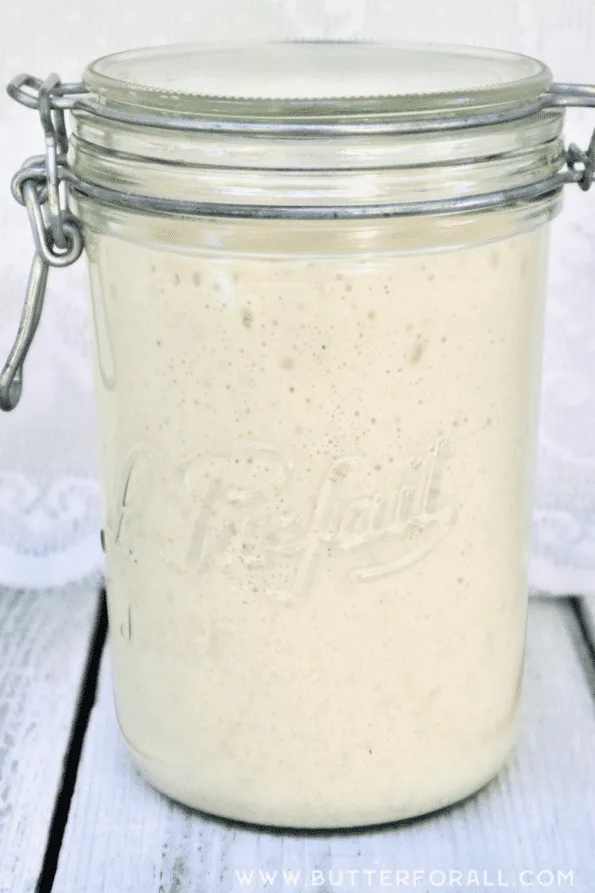
Refreshing Sourdough From the Refrigerator
Refreshing a Small (50- to 100-gram) Refrigerated Starter
- Remove your starter from the refrigerator and build it up to the desired size by feeding it with fresh flour and water. Allow it to ferment at room temperature until it reaches an active stage. Note: It may take two or more feedings for a very fermented starter to bounce back.
- Use a portion of the starter in your baking project. Always save 10 to 20 grams to inoculate your next batch of starter.
- Feed the saved portion with a 1:2:2 ratio (one part starter, two parts flour, and two parts water). Allow the starter to ferment at room temperature until bubbles start to form.
- Place the starter back in the refrigerator until it is needed again.
- Repeat this process as often as desired.
Refreshing a Large (300- to 500-gram) Refrigerated Starter
- Remove your large starter from the refrigerator and allow it to come to room temperature.
- Use a large portion of the refrigerated starter. If the starter is sour, use a recipe where sourdough starter discard is appropriate. If the starter is sweet and bubbly it may be used in any recipe. Note: A healthy well-balanced starter may not need to be fed before making bread.
- Feed the remaining starter with fresh flour and water, building it up to the desired size. Allow the starter to ferment at room temperature until it reaches an active stage.
- Either use a portion of the active starter in another project or put the starter back into the refrigerator.
- If you used some of the starter in step 4, feed it back up again now and allow it to start fermenting at room temperature before refrigeration.
How To Feed Your Sourdough Starter
Weighing your ingredients on a scale is a very important step in creating an easy-to-use and super-happy sourdough starter. The following instructions outline how to feed a 100% hydration starter (equal weights flour and water).
I recommend that an established starter be fed on a 1:2:2 ratio (one part starter, two parts flour, and two parts water). This gives the fermented starter plenty of fresh food and will create a vigorous, healthy, and well-balanced new starter.
Step 1
- Determine how much starter you need (e.g. 250 grams) or how much you want to feed (e.g. 50 grams).
- Place a bowl or jar on the scale and set the weight to grams.
- Make sure to zero out the scale after placing the bowl on it but before adding any ingredients.
- Add 50 grams (one part) of your previous batch of sourdough starter.
Note: You can adjust how much fresh starter you make by using more or less fermented starter. If you have 100 grams of fermented starter you would feed it with 200 grams of flour and 200 grams of water, growing your starter to 500 grams. No matter what amount you start with, always use the same 1:2:2 ratio (e.g. 33:66:66 = 165 grams).
Step 2
- Add 100 grams (two parts) of organic flour to the bowl or jar.
Personally and for starter feeding purposes, I use organic all-purpose flour and save my expensive local wheat and other heirloom and ancient grains for my bread.
Step 3
- Zero out the scale and add 100 grams (2 parts) water.
Using filtered water is the best practice. I recommend the Berkey Filters. They are the top-of-the-line, have great filter life, and are portable. You can even add on the fluoride/arsenic filters if your city or well water is contaminated.
If you don’t have access to filtered water you can use tap water that has been allowed to off-gas chlorine for at least 24 hours. Chlorine and other water additives can have a negative effect on sourdough microorganisms.
Step 4
- Use a spoon or dough whisk to mix the starter until all the dry flour is incorporated and the mixture is fairly smooth.
Step 5 – Storing and Fermenting Your Starter
- Place the starter in a storage container like this locking-lid glass jar.
I keep my starter in this large size so it has plenty of room to expand.
Make sure to remove the rubber sealing ring from the jar; this will allow the starter to breathe.
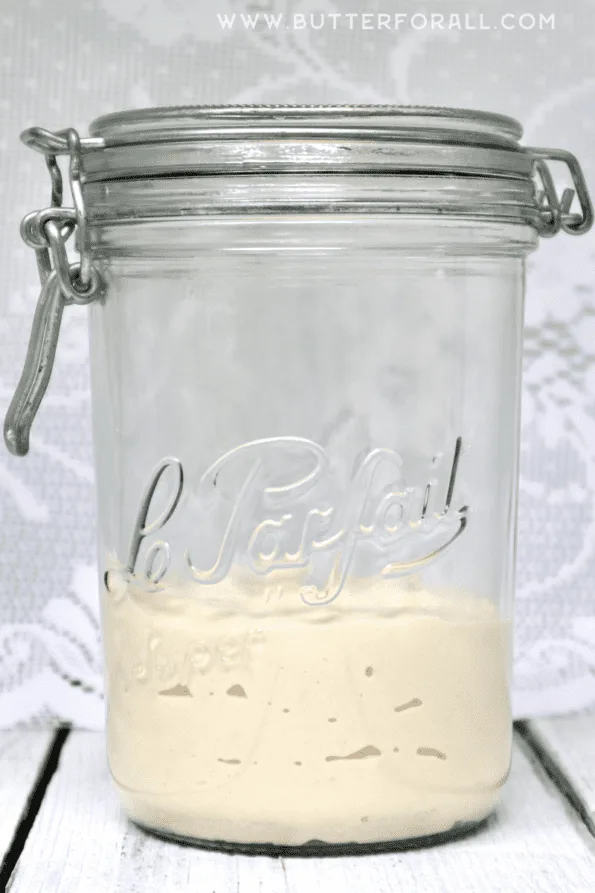
Step 6
- Let your starter ferment at room temperature.
In this picture the starter has doubled in size but has not yet peaked. If you are going to store your starter in the refrigerator, put it away now.
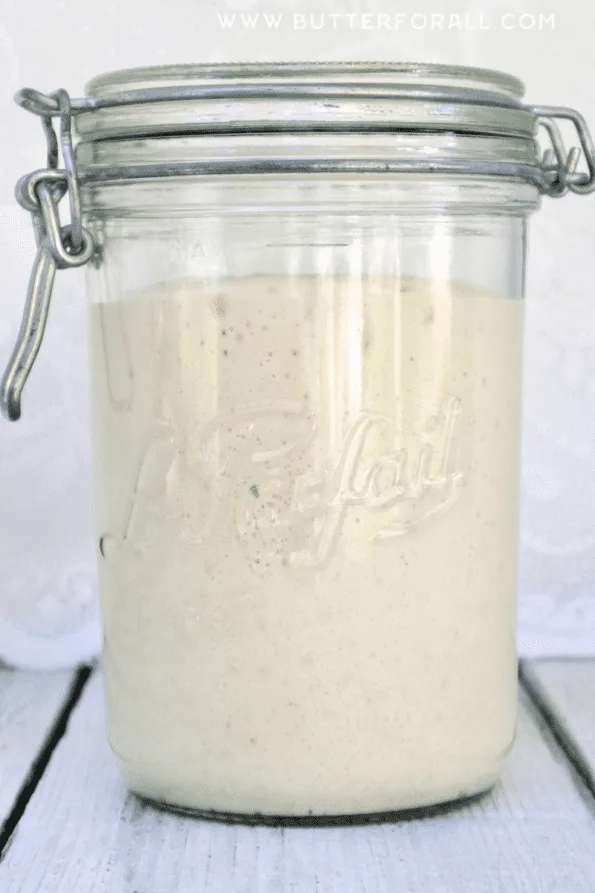
Step 7
In this photo the starter has “peaked.” This means it has reached its peak fermentation and is at its most active.
At this point your starter is definitely ready to be incorporated into recipes. If using cups and spoons measurements, make sure to stir your starter down before measuring it.
Don’t forget to feed your starter again after using it. Again, always feed your starter before you put it away in the fridge!

Great Recipes for Using Your Fed and Active Starter
How To Bake the Perfect Sourdough Boule in Your Dutch Oven
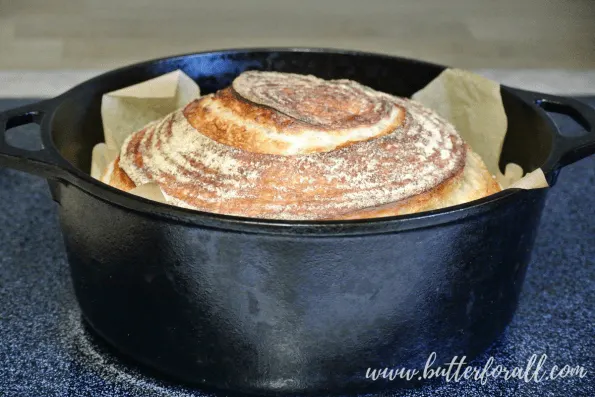
Cinnamon Raisin Sourdough Bread
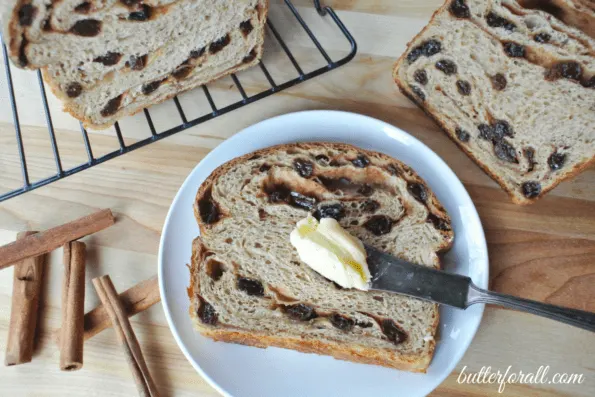
Sourdough Banana Nut Butter Muffins
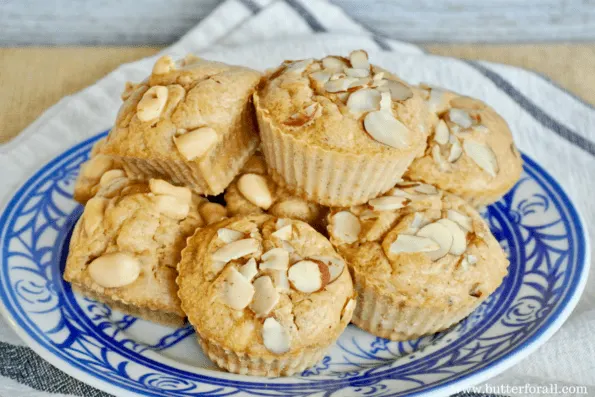

Heather
Tuesday 20th of February 2024
Hi there. I've read several of your articles on sourdough. I'm new and trying to understand everything I can. I can't figure out how to know when my starter has "peaked"? Is this at the 12hr mark? Thank you.
Butter For All
Tuesday 20th of February 2024
Hi Heather, I'm so glad you're finding my information helpful. "Peaked" doesn't have anything to do with time, it is when your starter has reached maximum fermentation. You'll know this because the starter will climb the sides of the jar, stop or "peak", and then fall back down again. It's basically just describing a very active starter that has more than doubled since feeding. I hope you find this helpful, and make sure to reach out again if you have any more questions! Happy baking, Courtney
Alana
Sunday 30th of July 2023
I have tried starter twice. It doubles by day 3 or 4 and then is not active. I have followed your recipe. HELP!
Butter For All
Saturday 12th of August 2023
I feel so bad that I missed this comment. I'm sorry you are struggling with your starter. What typically happens is the starter will get going with some bacteria and yeast in the beginning, in those first couple days, but it needs a little bit longer to balance out. So you have to just keep feeding it for up to two weeks for it to really get strong. I know it seems like it's not doing anything after the first three or four days, but just keep plugging away with it. It will eventually get there. You can try inoculating your flour with a piece of fruit or switch to an organic whole wheat brand and see if that helps. If that doesn't work, I'm happy to send you some of my dehydrated starter if you pay shipping and handling. Email me at courtney@butterforall.com if you're interested.
good luck!
bianca bandhaya
Thursday 23rd of March 2023
how much sourdough start do I use for a loaf of bread?
Butter For All
Monday 27th of March 2023
Hi Bianca,
It depends on the recipe. Usually it's about 20-30% of the weight of the flour. Some of my recipes call for greater percentages to contribute a nice sourdough flavor. In general, you can assume you'll need between 100-300g. You'll want to feed your active starter up to the desired weight about 8-12 hours before using the starter in a recipe. Always make a little extra to start a new batch of starter after you remove the required amount.
Pam
Thursday 23rd of February 2023
I have been removing one cup of starter then feeding it one cup flour and one cup water,it is new starter.is this correct or am I doing this wrong? Don't have Dutch oven to bake bread in can you bake sour dough another way.and also don't have proofing basket Thanks
Butter For All
Monday 27th of February 2023
You can bake bread open in the oven on baking sheets or pizza stones, loaf pans work great, there are even recipes like English muffins, crepes and pancakes that don't require an oven at all. You can shape a round loaf, and put it in a glass or ceramic bowl lined with a flour dusted tea towel for proofing. When it is ready to bake, just turn it out onto a baking sheet.
Butter For All
Monday 27th of February 2023
Hi Pam!
Well as long as it's working then that should be fine. There isn't really a definitive ratio for starter feeding. A higher hydration starter with more water will ferment faster and wont rise in the jar as well. A lower hydration starter will ferment slower and will show its rising more. If you aren't worried about weighing the starter for accuracy, then aiming for a consistency similar to muffin batter works well. Starters aren't really that picky. They just want to be fed! So again, if it's working, rising, making bread, you are fine!
sue
Friday 10th of February 2023
Great to find your site, i started a starter last friday and the recipe i used said to leave it undisterbed in a cool room with a tea cloth over it for five days, i took a peek this morning and it has risen and gone down but it has formed a thick grey skin on the top, is this normal
Butter For All
Thursday 16th of February 2023
Hi Sue,
I don't recommend a tea cloth. When the top of the starter dries out like that it will have a greater chance of molding. You can see my instructions for reviving dehydrated starter that will work as a schedule for a new starter as well. If you get really stuck, I also offer consultation!
Good luck!